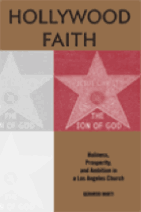 A bold, new history on modern evangelicalism titled Witnessing Suburbia
A bold, new history on modern evangelicalism titled Witnessing Suburbia came through my email today. Here's a quick look.
came through my email today. Here's a quick look.
Christian Pop in the SuburbsHistorian Eileen Luhr has written on how religion, family, and media came together to reshape politics.
Witnessing Suburbia: Conservatives and Christian Youth Culture
The book is described as a new "cultural analysis" on how national politics moved decidedly "right" in the Reagan-Bush era. She writes, "this study explores Christian conservatives' shifting attitudes toward youth culture to provide insight into how religious conservatives attempted to reenter public conversations about culture at the end of the twentieth century."
From what I gather in the publisher's description and preview, Luhr brings us the story of how Christian parents and concerned ministers became "activists" in the 1980s for protecting their youth. She focuses much of the work on music -- as rock-and-roll became saturated in American life, evangelicals reconsidered their approach to culture and introduced new innovations.
Overall, she privileges the ability of evangelicals to infiltrate American suburbs and adopt consumer themes. She shows how conservative evangelical involvement with meda had wide political implications.
Concern for Youth Leads to Political Shifts
In the book, Luhr writes "how conservative Christians linked youth culture and social problems and how they aggressively sought to reestablish 'youth' as a category of innocence in need of adult protection during the late-twentieth-century culture wars." She writes about the rise of pop music that included Christian heavy metal (remember
Stryper?) and Christian rock festivals.
What makes this book important is how it connecting these developments to the political surge of the Religious Right.
Reading the first chapter, I see how she captures a moment in evangelical culture in the early 1980s when record-burning and exposing Satan's hidden lyrics through backward masking moved conservative families to reject the rock-and-roll culture and the sex, drugs, and wild living that went with it. This set up a context for crafting a new Christian pop culture.
She says the creation of a new approach to "popular" (
read "mass media") culture was part of a "modernization" project. And I think she's right. She describes the shift from Old Right to New Right:
Evangelicals' cultural interventions reflected a critical shift in conservative religious affinities from Old Right to New Right as evangelicals developed "modern" middle-class suburban sensibilities and consumer habits.
In both old and new mindsets, the family provided a critical building block of Christian society, and believers worried that a secular worldview encroached on familial authority. Proponents of both views feared that popular culture had replaced parents and church as the primary source of children's socialization.
Strict fundamentalists avoided contamination of the Christian worldview by swearing off secular culture—at least in name.
Conversely, suburbanized evangelicals...cautiously accepted television and music into the domestic circle but attempted to maintain careful adult guidance over message and interpretation.
As far as I can tell, playing out this transition is the theme of the book.
Understanding this piece of history a bit more closely, we come to understand yet another aspect of how modernity re-shaped evangelicalism in various ways. This contributes another piece of the puzzle to marking the rise of megachurches, the incorporation of entertainment, the shift in dress codes, the bringing in of movies and top 40 music into "contemporary" services, and a whole host of other developments thousands of church-goers consider quite "normal" today.
And it gives us another opportunity to reflect on religion and culture.
Check It OutThere's more in the book. Here are the core chapters (and Chapter 1 is now available online):
1. Home Improvement: Christian Cultural Criticism and the Defense of "Traditional" Authority2. Rebel with a Cross: The Creation of a Christian Youth Culture
3. Metal Missionaries to the Nation: Christian Heavy Metal Music, 1984-1994
4. "An MTV Approach to Evangelism": The Cultural Politics of Suburban Revivalism









































